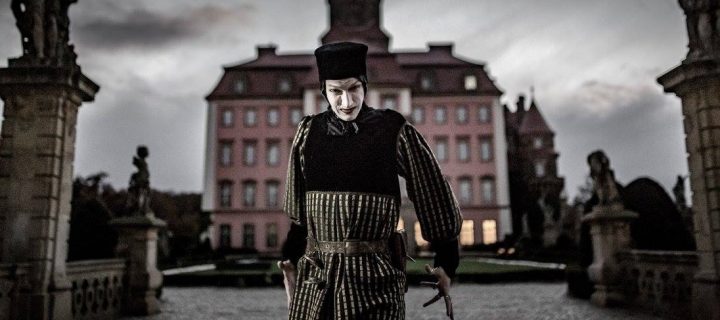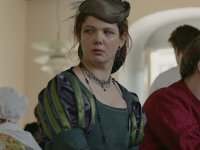Convention of Thorns is an official White Wolf Nordic-style Vampire: the Masquerade larp. The first run was held between October 27-30, 2016 at Zamek Książ, a castle in Poland. The larp was a joint collaboration between White Wolf and Dziobak Larp Studios. This scenario plays out a crucial moment in the canon of vampiric history, in which representatives from various cities across Europe, Western Asia, and Northern Africa engage in peace talks at a meeting in Thorns, England in 1493.[1]For general information, see The Unofficial White Wolf Wiki, “Convention of Thorns,” Whitewolf.wika.com, December 4, 2015. http://whitewolf.wikia.com/wiki/Convention_of_Thorns

The Nosferatu Josef von Bauren, one of the Founders of the Camarilla. Photo by John-Paul Bichard.
During this time, the Inquisition was purging many of the vampires throughout Europe. The Kindred were involved in a brutal civil war, in which elder members of the Establishment attempted to maintain their power while younger Anarchs rose up to kill and usurp them in a bloody revolution. The Convention represents an attempt to establish a code of rules – or Traditions — as well as to standardize a new form of government called the Camarilla, which is based mainly on Establishment values. In the White Wolf canon, this event leads to the official division between the Camarilla, the Anarchs, the Independent clans, and a new sect called the Sabbat. The latter factions ultimately reject the Camarilla’s authority, with the fledgling Sabbat declaring a war upon the Establishment that endures through the modern nights.
While larp groups have organized immersive, Nordic style Vampire games before,[2]Jaakko Stenros and Markus Montola, eds. Nordic Larp (Stockholm, Sweden: Fëa Livia, 2010). as well as several one-shots set in the canonical Convention of Thorns, this event marks a historically significant moment in the development of White Wolf larp. This larp represents an effort by White Wolf to embrace the blockbuster style of larp,[3]Eirik Fatland and Markus Montola, “The Blockbuster Formula – Brute Force Design in The Monitor Celestra and College of Wizardry,” Nordiclarp.org, May 6, 2015. https://nordiclarp.org/2015/05/06/the-blockbuster-formula-brute-force-design-in-the-monitor-celestra-and-college-of-wizardry/ which features high production values, an expensive location, richly detailed setting information packed into pre-written characters, and some plots or NPCs deployed by the organizers during the game.

The Tzimisce Irenka Brozek, the White Spider. Photo by Przemysław Jendroska and Nadina Wiórkiewicz for Dziobak Larp Studios.
Blockbuster larps are a form of what one of Convention of Thorns’ designers, Claus Raasted, calls larp tourism, in which players can use time and resources usually reserved for a vacation to larp in an impressive setting and have an immersive experience.[4]Claus Raasted, “Claus Raasted: Larp Tourism (Produced for Nelco 2015).” YouTube, August 28, 2015. https://www.youtube.com/watch?v=r0Lu9ct_se4 Such projects draw participants from around the world, are well documented, and garner a remarkable amount of mainstream attention, as witnessed by the media frenzy around the College of Wizardry larps. True to form, Convention of Thorns attracted players from several countries, producing impressive documentation photos of the authentic-looking castle, costuming, and prosthetics from several photographers, including John-Paul Bichard, Przemysław Jendroska, and Nadina Wiórkiewicz. These new White Wolf larps such as Convention of Thorns, End of the Line, and the upcoming Enlightenment in Blood are not intended to replace traditional Vampire games, but rather to augment them, by creating one-shot, uniquely immersive experiences set in the World of Darkness.

The Camarilla Ventrue Founder Hardestadt addresses the assembled Kindred in the opening scene. Photo by Przemysław Jendroska and Nadina Wiórkiewicz for Dziobak Larp Studios.
Consent Negotiations, Day Play, and Collaborative Style
While the blockbuster style is certainly visually impressive, the Nordic roots of these games also represent a departure from White Wolf’s usual type of larps in their embodiment of physicality. The game did feature a few mechanics, most notably in the use of the “really really” mechanic for simulating Discipline use. Originating in White Wolf and Odyssé’s End of the Line, a player could lay a hand on another player and issue a verbal command with the words “really really” to indicate the use of a Dominate, Presence, or Auspex command. However, physical combat was highly discouraged. Unlike most Vampire larps from the Mind’s Eye Theatre tradition, no traits are spent to perform actions and no rock-paper-scissor throws resolve conflict. Instead, Convention of Thorns used a consent-based style of play, in which players negotiate violence, intimacy, and feeding through a scripted off-game consent negotiation workshopped before the game. Developed and piloted at the New Orleans run of End of the Line, these negotiations required players to discuss openly physical and emotional boundaries before engaging in scenes with sensitive content.[5]For more on the safety and calibration tools developed for End of the Line, see Johanna Koljonen, Safety in Larp: Understanding Participation and Designing for Trust, September 18, 2019. https://participationsafety.wordpress.com

Tzimisce enemies Premislav Aksinin and Piotr Danchina confront one another. In consent-based play, conflict resolution is negotiated off-game with all parties agreeing on the outcome. Photo by Przemysław Jendroska and Nadina Wiórkiewicz for Dziobak Larp Studios.
Additionally, in consent-based play, all participants agree upon the outcome of an event based upon their out-of-character needs, rather than their character’s abilities, points, or role-play driven motivations. Consent-based play has proven highly successful at creating a culture of safety, play-style calibration, and trust,[6]Game to Grow, “Game to Grow Webisode Project Episode 2: Emotionally Intense Play, Calibration, and Community Safety,” YouTube, September 1, 2016. https://www.youtube.com/watch?v=3YtRJd5CR2I even in role-play environments such as New World Magischola in the United States,[7]Maury Brown, “Creating a Culture of Trust through Safety and Calibration Larp Mechanics,” Nordiclarp.org, September 9, 2016. https://nordiclarp.org/2016/09/09/creating-culture-trust-safety-calibration-larp-mechanics/ which attract both new players and larpers from more traditional settings with conflict resolution mechanics. These consent mechanics aligned with the overall goals of the Safety team at Convention of Thorns, of which I was a part: to create an environment where players felt safe to engage in whatever level of intensity of play they desired and, most importantly, felt comfortable disengaging or opting-out of content if needed. Therefore, an hour of workshop time was set aside to practice safety techniques and negotiation.[8]For the complete Safety workshop instructions, click here: https://docs.google.com/document/d/1yTgK4ZKqg9H9opBKau7nKZC3y5jOqwlo7D4PWCKPB5s/edit?usp=sharing
Along these lines, a major point of departure from traditional Vampire larps was the emphasis on transparency in Convention of Thorns. In the Nordic style, the goal of the game is not to succeed or “win” in a traditional sense, but rather to “play to lose,” or “play for what is interesting.” For this reason, all of the character sheets, casting, and Domain relationships were visible to the players before the start of the larp. In a game that centers upon information hoarding, power dynamics, plotting, and secrecy, this design choice was remarkably effective. Similarly, in pre-game planning, participants were able to communicate their interests on Facebook for particular types of play, including posting Looking for Relations requests, creating groups, and asking for specific relationships such as sire/childe, love interests, rivals, etc. Players often aired their character’s secrets in public forums in order to create more drama in game, broadcasting to others what themes they find most interesting to play.

The Toreador Geneveve Orseau. Photo by Przemysław Jendroska and Nadina Wiórkiewicz for Dziobak Larp Studios.
For example, I played Geneveve Orseau, an Enlightenment-seeking Toreador co-Harpy in the Domain of Paris. Geneveve ran an art academy and salon, which functioned as a civilizing finishing school for young Kindred. Before game, I created a Facebook group for salon attendees and students, establishing a group of people who may not agree on important topics such as humanity, art, or philosophy, but who had met one another socially in the past.
Another player created a group called Correspondence in Humanities, for those of us interested in playing on the theme of trying to regain our humanity. In a sense, this group ended up having a double meaning, as the characters within it wrote one another long letters on the nature of vampiric existence, the practicalities of trying to grapple with the inner Beast, and reflections on spirituality that deeply resonated with the humanistic Renaissance setting. This sort of pre-play helped participants locate co-players interested in the same sorts of interactions and themes, establishing ties and creating relationships before arriving on site. In my experience, these ties greatly aid in facilitating excellent scenes with these co-players on-site. For example, the Humanities group developed a secret handshake to indicate their interest in Golconda and also organized a discussion on the nature of Enlightenment around an altar during the larp.
In addition, while game play took place at night, the daytime hours were reserved for Day Play and collaborative planning. As a player, this element of the game most inspired my participation. Building upon Nordic and American freeform techniques, I co-wrote the Day Play instructions[9]For the complete Day Play instructions, click here: https://docs.google.com/document/d/1YlYay_h2IctkRQ3Kt6jqXYMK87aMon9Q6d0xyR55qIc/edit?usp=sharing with Maury Brown, using a system I originally developed for Planetfall larp in Austin, Texas.[10]Matthew Webb, “Imagining the Future with Planetfall: Mobile Technology and Hard Science in Science Fiction Larping,” in The Wyrd Con Companion Book 2015, edited by Sarah Lynne Bowman (Los Angeles, CA: Wyrd Con) https://www.dropbox.com/s/xslwh0uxa544029/WCCB15-Final.pdf?dl=0

Day Play cards. Photo by Renee Ritchie.
In Day Play, facilitators led small groups of players through a series of scenes in which they could enact parts of their backstory, fantasies, dreams, or future events. In a game like Vampire, where characters are many decades or even centuries old, past memories and traumas are often formative to the psychological makeup of the Kindred. During Day Play, participants could enact their own characters, NPCs, or simply watch. Some players opted to create their own scenes; others used the card system, where participants drew an emotion and a scenario from two decks. The facilitator would then guide the group through developing the scene, using metatechniques such as angel and demon (a variant of bird-in-the-ear), monologue, rewind/fast forward, Last Line, and Switch.[11]See Day Play Instructions above for definitions. These scenes also contributed to the atmosphere of collaborative play and transparency. Participants witnessed scenes that would normally remain hidden, enabling them to steer toward content during the evening that would inspire deeper scenes. Day Play allowed participants insight into the motivations and emotions of the other characters.

The Malkavian Vasantasena comforts the Nosferatu Dáire mac Donnchada. While evening play took place in the castle with full costuming and scenography, Day Play was freeform style in street clothes. Photo by Przemysław Jendroska and Nadina Wiórkiewicz for Dziobak Larp Studios.
Participation in Day Play was strictly optional and some players opted to eat, socialize, sleep, or plan out-of-character. This relaxed atmosphere also lent to the collaborative style of play. While players did plot, as they often do in between Vampire larp sessions, they mostly did so as large groups. The consent-based play encouraged participants to negotiate and agree upon the outcomes of confrontations off-game.

Jürgen von Verden, who masqueraded as his sire, Hardestadt. Photo by Jean-Paul Bichard.
For example, my character Geneveve had maintained a centuries-long secret love affair with Jürgen von Verden, a Ventrue Crusader. Jürgen was hiding the relationship from his sire, Lord Hardestadt, who became one of the Founders of the Camarilla. A central canonical conceit of Convention of Thorns is that Hardestadt is killed by the Anarch Tyler decades before, and Jürgen must masquerade as his sire in order to keep the dream of the Camarilla alive. In our story line, the two characters had not seen one another since this transformation until the Convention. This relationship dynamic was player-driven rather than established by the canon or the team of writers, representing an alternate history version of events.
During the daytime hours before the final game session, we collectively planned several major events in our small groups. For example, we plotted the complete destabilization of the Domain of Paris due to the Prince becoming an Anarch and the Seneschal getting killed, as well as the selection of a new Prince, who had been the Sheriff. In addition, we decided that after the clans had voted on their participation in the Camarilla, Jürgen would run off to Paris to live with Geneveve, abandoning his mantle as Hardestadt and retiring from politics, at least temporarily. Many players were informed of this decision and the power vacuum created by Hardestadt’s departure was resolved through out-of-character discussion, with a new Justicar pre-determined to stand in his place. In traditional Vampire games, players would plan such maneuvers secretly, then enact them in game with uncertain results in a competitive style. Alternatively, we had determined these outcomes as larger collective groups, which did not diminish their intensity in play, but rather magnified it.
Player Agency Trumping Canonical Authenticity
These examples illustrate some key principles about Convention of Thorns: the emphasis on transparency, collaborative play, and the power of player agency to change canonical endings as their personal stories demanded. We were permitted a certain degree of freedom to play with canonical “truths,” as players were only required to read the Design Document and their character sheets.

While some political meetings occurred, the majority of social play transpired in the ballroom. Photo by Przemysław Jendroska and Nadina Wiórkiewicz for Dziobak Larp Studios.
The ability to change the outcome of the Convention was of particular interest to many players. The game was structured around clan meetings, council deliberations, and votes. However, these events were intended to be short and not dominate the social play of the game, which took place mainly in a large ballroom. In this regard, while we could not change the number of Traditions or the scheduled times of the votes, we could alter the wording of the Traditions, which resulted in some surprising departures from canon:

Photo courtesy of Eva Wei.
Additionally, clans that were normally considered Independent, such as the Giovanni and the Ravnos, ended up joining the Camarilla.
In this regard, players felt some flexibility not only to bend canon as desired, but also to bend history. Although the larp was set in the Renaissance, players were not expected to memorize historical facts or dress in strictly period-appropriate costuming. While White Wolf officially endorsed Convention of Thorns, these canonical changes are not meant to alter the existing timelines, but rather to serve as an alternative history. In future runs of the game, other deviations from established storylines are likely to emerge as players explore their own desired interests, relationships, and themes.

The Nosferatu Andrei Romanovich confers with his Clan. Photo by Przemysław Jendroska and Nadina Wiórkiewicz for Dziobak Larp Studios.
Variable Degrees of Engagement
While the castle itself offered a stunning location, complete with a gold-gilded ballroom for the opening scene and character portraits, the scenography team transformed several rooms in the castle to suit various moods and styles of play. The main floor of the castle was the primary area of play, including another ballroom and antechamber, where social and political scenes unfolded. Intact and destroyed areas of the castle were converted to Clan rooms, complete with themed music, special décor, and even unique smells. The top layer of the castle was reserved for players interested in darker, more visceral scenes, including rituals, intimacy, and violence.

The scenographers designed each Clan room with an individualized aesthetic. Photo by Przemysław Jendroska and Nadina Wiórkiewicz for Dziobak Larp Studios.
In this regard, players could choose their desired level of intensity with darker content based upon their location in the castle to a certain degree. NPCs were deployed primarily as monk retainers in service to the Abbey of Thorns or as humans to be fed upon in various ways. The emphasis on feeding served as a reminder of the Bestial nature of the vampiric existence, with the second major scene of the game after the opening speeches being a “feast,” complete with screaming villagers offered to the guests as meals. As my character, Geneveve, fed almost entirely on animal blood as a way to stave off her vampiric side, she completely avoided these screams, finding solace in the small antechamber. Throughout the larp, this space functioned as a makeshift salon and was relatively free of violence. In this way, the physical location and scenographic design afforded players some degree of control over the experiences they wished to explore.

The Lasombra Francesca Della Rovere. Photo by Przemysław Jendroska and Nadina Wiórkiewicz for Dziobak Larp Studios.
Similarly, the game was scaled structurally in terms of power level and intensity. Regardless of their power level, characters could only use low level Disciplines on the first night, medium level ones on the next night, and high ones on the last night. Similarly, characters could not die or be diablerized until the last night, encouraging players to ratchet up the tension and intensity until the climax of the game. Combined with the consent-based play, these techniques assuaged some of the fears of the participants regarding the inequity of power levels and the physicality of the playstyle.

The Brujah Anarch Tyler reviews the new Traditions. Photo by Przemysław Jendroska and Nadina Wiórkiewicz for Dziobak Larp Studios.
The organizers encouraged us to think of these peace talks as the equivalent of the vampiric UN — where violence would be rare and unseemly — rather than a battleground. In the final scene, the factions split onto two sides of the ballroom: one in favor of the Camarilla and one against. As many chanted the word “war” while staring at their opponents, the organizers ended the game. Therefore, the intensity of the violent intent remained, while the details of what happened in the future could be negotiated by players as they wished after the game or in Day Play scenes.

The Toreador Rosado Trastámara. Some Kindred played upon their more monstrous side, whereas others tried to preserve their Humanity. Photo by Przemysław Jendroska and Nadina Wiórkiewicz for Dziobak Larp Studios.
A Bright Future for the World of Darkness
Convention of Thorns represents the latest in a series of games developed by White Wolf in conjunction with designers in the Nordic scene. The organizers announced that they will rerun the larp next year, with details forthcoming. Meanwhile, several cities have expressed interest in hosting End of the Line, with two runs scheduled for World of Darkness Berlin, a White Wolf convention that will take place May 11-14, 2017. World of Darkness Berlin will also feature talks, workshops, the new documentary on the history of White Wolf, and the delightful dance-off larp, Dancing with the Clans. Finally, participants can look forward to Enlightenment in Blood, a several hundred person pervasive larp[12]“Pervasive Game,” Wikipedia, November 13, 2016. https://en.wikipedia.org/wiki/Pervasive_game set in modern times that spans multiple locations around the city of Berlin. In short, games like Convention of Thorns point strongly toward a bright future for the World of Darkness.

In the final scene, White Wolf Lead Storyteller Martin Elricsson narrates future events after the Convention, standing between the Kindred battle lines. Photo by Przemysław Jendroska and Nadina Wiórkiewicz for Dziobak Larp Studios.
Convention of Thorns
Participation Fee: €480-530
Players: 175-190
Date: October 27-30, 2016
Location: Zamek Książ, Poland
Production: White Wolf Publishing and Dziobak Larp Studios, Claus Raasted
Logistics and Volunteer Coordinator: Agata Świstak
Lead Character Writer: Edin Jankovic Sumar
Location: Szymon Boruta
Costumes: Agnieszka “Linka” Hawryluk, Szymon Boruta, Mikołaj Wicher
Scenography: Agnieszka “Linka” Hawryluk, Szymon Boruta, Agata Świstak
Technical Support: Mikołaj Wicher
Promotion: Fred Brand
Safety Team: Agata Świstak, Petra Lindve, Sarah Lynne Bowman, Maury Brown, Mila Ingalls, Claus Raasted Herløvsen
Main Character Writers: Anders Edgar, Jamie Snetsinger, Petra Lindve, Mia Devald Kyhn, Arvid Björklund, Simon Svensson, Frida Selvén, Jørn Slemdal, Anna-Lisa “Muckas” Gustavsson, Magnus Thirup Hansen
Volunteer Writers: Richard Svahn, Sorcières Cat, Andreas Svedin, Stefan Lunneborg, Freja Lunau, Elina Gouliou, Mathias Oliver Lykke Christensen, Garett Kopczynski, Marta Szyndler, Vilhelmīne Ozoliņa, Nika Anuk
Day Play Designers: Sarah Lynne Bowman and Maury Brown
Documentation: John-Paul Bichard, Magdalena Gutkowska, Aleksander Krzystyniak, Przemysław Jendroska, Maciej Nitka, Nadina Wiórkiewicz
Props: Yoru Kamiko, Marta Szyndler
Production assistants: Eevi Korhonen, Radek Gołdy, Halfdan Keller Justesen, Joanna Janik, Richard Svahn, Janina Wicher, Joanna Maryniak, Ania Gęborska, Ida Pawłowicz, Ole Risgaard Hansen, Samuel Arnold, Kasper Lundqvist, Johannessen, Freja Lunau, Yleine Aerts, Eva Helene Antonsen, Christine M. Christensen, Linnea Fredin, Katrine Kavli, Louise Svedsen, Kamilla Brichs, Mira Suovanen, Antti Kumpulainen, Lau K Lauritzen, Suus Matsaers, Stefan Lindgren, Casper Gatke, Dracan Dembiński, Herwig Kopp, Piotr “Kula” Milewski, Ola Wicher, Olivier Hoffman, Mila Ould Yahoui
Cover photo: The Malkavian Celestyn, The Librarian. Photo by Przemysław Jendroska and Nadina Wiórkiewicz for Dziobak Larp Studios.
References
| ↑1 | For general information, see The Unofficial White Wolf Wiki, “Convention of Thorns,” Whitewolf.wika.com, December 4, 2015. http://whitewolf.wikia.com/wiki/Convention_of_Thorns |
|---|---|
| ↑2 | Jaakko Stenros and Markus Montola, eds. Nordic Larp (Stockholm, Sweden: Fëa Livia, 2010). |
| ↑3 | Eirik Fatland and Markus Montola, “The Blockbuster Formula – Brute Force Design in The Monitor Celestra and College of Wizardry,” Nordiclarp.org, May 6, 2015. https://nordiclarp.org/2015/05/06/the-blockbuster-formula-brute-force-design-in-the-monitor-celestra-and-college-of-wizardry/ |
| ↑4 | Claus Raasted, “Claus Raasted: Larp Tourism (Produced for Nelco 2015).” YouTube, August 28, 2015. https://www.youtube.com/watch?v=r0Lu9ct_se4 |
| ↑5 | For more on the safety and calibration tools developed for End of the Line, see Johanna Koljonen, Safety in Larp: Understanding Participation and Designing for Trust, September 18, 2019. https://participationsafety.wordpress.com |
| ↑6 | Game to Grow, “Game to Grow Webisode Project Episode 2: Emotionally Intense Play, Calibration, and Community Safety,” YouTube, September 1, 2016. https://www.youtube.com/watch?v=3YtRJd5CR2I |
| ↑7 | Maury Brown, “Creating a Culture of Trust through Safety and Calibration Larp Mechanics,” Nordiclarp.org, September 9, 2016. https://nordiclarp.org/2016/09/09/creating-culture-trust-safety-calibration-larp-mechanics/ |
| ↑8 | For the complete Safety workshop instructions, click here: https://docs.google.com/document/d/1yTgK4ZKqg9H9opBKau7nKZC3y5jOqwlo7D4PWCKPB5s/edit?usp=sharing |
| ↑9 | For the complete Day Play instructions, click here: https://docs.google.com/document/d/1YlYay_h2IctkRQ3Kt6jqXYMK87aMon9Q6d0xyR55qIc/edit?usp=sharing |
| ↑10 | Matthew Webb, “Imagining the Future with Planetfall: Mobile Technology and Hard Science in Science Fiction Larping,” in The Wyrd Con Companion Book 2015, edited by Sarah Lynne Bowman (Los Angeles, CA: Wyrd Con) https://www.dropbox.com/s/xslwh0uxa544029/WCCB15-Final.pdf?dl=0 |
| ↑11 | See Day Play Instructions above for definitions. |
| ↑12 | “Pervasive Game,” Wikipedia, November 13, 2016. https://en.wikipedia.org/wiki/Pervasive_game |






